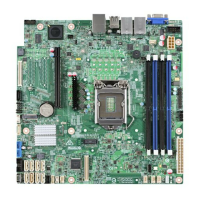Intel® Server Board S1200SP Family Technical Product Specification
69
device appears just like a local device to the server, allowing system administrators or users to install software
(including operating systems), copy files, update BIOS, and so on, or boot the server from this device.
The following capabilities are supported:
• The operation of remotely mounted devices is independent of the local devices on the server. Both remote
and local devices are useable in parallel.
• Either IDE (CD-ROM, floppy) or USB devices can be mounted as a remote device to the server.
• It is possible to boot all supported operating systems from the remotely mounted device and to boot from
disk IMAGE (*.IMG) and CD-ROM or DVD-ROM ISO files. See the Tested/supported Operating System List
for more information.
• Media redirection supports redirection for both a virtual CD device and a virtual Floppy/USB device
concurrently. The CD device may be either a local CD drive or else an ISO image file; the Floppy/USB device
may be a local Floppy drive, a local USB device, or a disk image file.
• The media redirection feature supports multiple encryption algorithms, including RC4 and AES. The actual
algorithm that is used is negotiated with the client based on the client’s capabilities.
• A remote media session is maintained even when the server is powered-off (in standby mode). No restart
of the remote media session is required during a server reset or power on/off. A BMC reset (for example,
due to a BMC reset after BMC FW update) requires the session to be re-established
• The mounted device is visible to (and useable by) managed system’s OS and BIOS in both pre-boot and
post-boot states.
• The mounted device shows up in the BIOS boot order and it is possible to change the BIOS boot order to
boot from this remote device.
• It is possible to install an operating system on a bare metal server (no OS present) using the remotely
mounted device. This may also require the use of KVM-r to configure the OS during install.
USB storage devices appear as floppy disks over media redirection. This allows for the installation of device
drivers during OS installation.
If either a virtual IDE or virtual floppy device is remotely attached during system boot, both the virtual IDE and
virtual floppy are presented as bootable devices. It is not possible to present only a single-mounted device
type to the system BIOS.
7.3.1 Availability
The default inactivity timeout is 30 minutes and is not user-configurable. Media redirection sessions persist
across system reset but not across an AC power loss or BMC reset.
7.3.2 Network Port Usage
The KVM and media redirection features use the following ports:
• 5120 – CD Redirection
• 5123 – FD Redirection
• 5124 – CD Redirection (Secure)
• 5127 – FD Redirection (Secure)
• 7578 – Video Redirection
• 7582 – Video Redirection (Secure)

